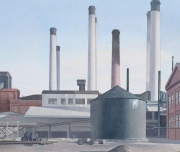Difference between revisions of "Masonite"
| Line 36: | Line 36: | ||
* Wikipedia: [https://en.wikipedia.org/wiki/Masonite Masonite] Accessed Nov. 2024 | * Wikipedia: [https://en.wikipedia.org/wiki/Masonite Masonite] Accessed Nov. 2024 | ||
* InspectAPedia: [https://inspectapedia.com/structure/Masonite-Definition-History-Composition.php Masonite and other Hardboards] Accessed Nov. 2024 | * InspectAPedia: [https://inspectapedia.com/structure/Masonite-Definition-History-Composition.php Masonite and other Hardboards] Accessed Nov. 2024 | ||
| + | *. M. Gottsegen, 'A Manual of Painting Materials and Painting Techniques' [https://inspectapedia.com/structure/Painting-on-Panel-Working-with-Masonite-Gottsegen-Ampersand.pdf] | ||
* C. Gould, K. Konrad, K. Milley, R. Gallagher, "Fiberboard", ''Twentieth-Century Building Materials'', T. Jester (ed.), McGraw-Hill: New York, 1995. | * C. Gould, K. Konrad, K. Milley, R. Gallagher, "Fiberboard", ''Twentieth-Century Building Materials'', T. Jester (ed.), McGraw-Hill: New York, 1995. | ||
* A.Katlan, "Early Wood-Fiber Panels: Masonite, Hardboard and Lower-Density Boards" ''JAIC'' 33:301-306, 1994. | * A.Katlan, "Early Wood-Fiber Panels: Masonite, Hardboard and Lower-Density Boards" ''JAIC'' 33:301-306, 1994. | ||
Revision as of 14:03, 12 November 2024
Description
Formerly, a registered trademark (Masonite Corp.) for a type of Hardboard construction material first made in 1924 by William H. Mason. The term 'masonite' is now a generic term for thin high-density fiberboards. Masonite Corp. was purchased by the Premdor Corp. in 2001.
Made by a wet-process, Masonite is a composed of 100% wood fibers compressed into a dense, rigid sheet with steam and heat. The fibers are held together by the natural lignocellulose binders from the pulp with no added adhesives. Masonite boards do not bend or warp easily but the sheets are brittle and break under pressure. The boards are brown in color with one very smooth surface; the reverse side has a wire screen impression due to the wire screening used for the moisture drainage (these are called S1S for smooth-one-side). The standard size for the boards is 4' x 8' with 1/8" or 1/4" thickness. Masonite is more resistant to insects and rot than natural wood, but it is very susceptible to water damage.
The following type Masonite boards were available in a 1935 Masonite Catalog:
- Insulation boards: Structural Insulation, Insulating lath, Beveled tile, Beveled Plank
- Quartrboard: Masonite sheets prepared in smaller widths
- Presdwood: Heat-treated sheets
- Tempered Pressdwood: Surfaces were oil then heat-treated; advertised as waterproof and weatherproof
All products were advertised as 'may be sawn, planed, sanded, nailed, cemented, painted, varnished or lacquered as thought they were boards of natural wood....further advantages of being free from knots, grain and splinters" [1]
Some artists have coated the rough surface with gesso and used it as a painting support. Tempered Masonite Presdwood was dipped oil then heated to add weather resistance to the board; this also made it less receptive to Paint or Gesso. Currently tempered hardwoods use very small amounts of oil , most of which is flashed of during the baking process
Synonyms and Related Terms
Presdwood; hardboard; fiberboard; high-density board
Risks
- Any wood product may release organic acids with time
- Fiberboards can absorb water and swell/warp
Working properties
- Masonite can be painted but not stained
- It won't chip or splinter
- Resistant to bugs and dents
- Easy to drill or cut with very sharp blades; may dull blades quickly
- Does not hold hails and screws as securely as natural wood
Resources and Citations
- Wikipedia: Masonite Accessed Nov. 2024
- InspectAPedia: Masonite and other Hardboards Accessed Nov. 2024
- . M. Gottsegen, 'A Manual of Painting Materials and Painting Techniques' [1]
- C. Gould, K. Konrad, K. Milley, R. Gallagher, "Fiberboard", Twentieth-Century Building Materials, T. Jester (ed.), McGraw-Hill: New York, 1995.
- A.Katlan, "Early Wood-Fiber Panels: Masonite, Hardboard and Lower-Density Boards" JAIC 33:301-306, 1994.
- Masonite: http://www.masonite.com/COMPANY/HISTORY.asp first made in 1924 by William H. Mason Note: this website was been discontinued in 2011
- The history on Masonite: Retrieved from http://www.masonite.com/COMPANY/HISTORY.asp via the Wayback machine]
